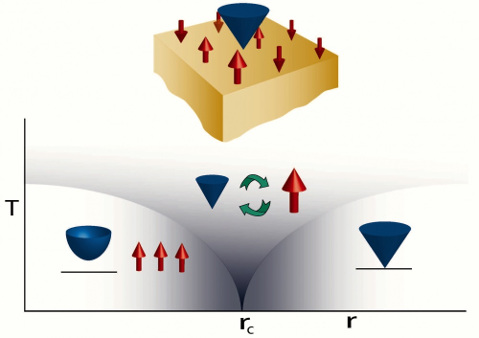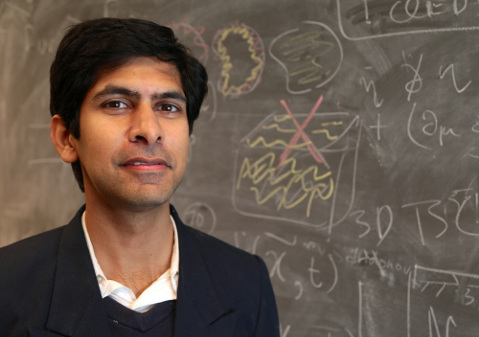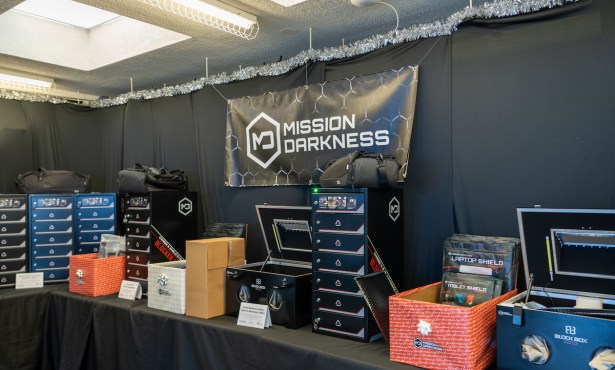Finding Supersymmetry Through Time-Reversal Symmetry
One Piece of Physics Puzzle Found to Emerge Naturally

UC Santa Barbara physicist Tarun Grover has provided definitive mathematical evidence for supersymmetry in a condensed matter system. Sought after in the realm of subatomic particles by physicists for several decades, supersymmetry describes a unique relationship between particles.
“As yet, no one has found supersymmetry in our universe, including at the Large Hadron Collider (LHC),” said the associate specialist at UCSB’s Kavli Institute for Theoretical Physics. He is referring to the underground laboratory in Switzerland where the famous Higgs boson was identified in 2012. “This is a fresh insight as to how supersymmetry arises in nature.” The findings of Grover’s research, conducted with colleagues Donna Sheng and Ashvin Vishwanath, appear in the current online edition of the journal Science.
The fundamental constituents of matter — electrons, quarks, and their relatives — are fermions. The particles associated with fundamental forces are called bosons. Several decades ago, physicists hypothesized that every type of particle in the Standard Model of particle physics, a theory that captures the dynamics of known subatomic particles, has one or more superpartners — other types of particles that share many of the same properties but differ in a crucial way.
If a particle is a fermion, its superpartner is a boson, and if a particle is a boson, its superpartner is a fermion. This is supersymmetry, a postulated unique theoretical symmetry of space.
While the Standard Model governing the ordinary world is not supersymmetric, it is often theorized that the more “fundamental” theory relevant to very hot systems, such as those probed in high-energy particle accelerators like the LHC (or higher energy ones yet to be built), might exhibit supersymmetry. This has yet to be proved or disproved by accelerator experiments.

However, through their calculations, Grover and his coauthors show that supersymmetry emerges naturally in a topological superconductor. An example is helium-3, a light, nonradioactive isotope of helium with two protons and one neutron (common helium has two neutrons). When helium-3 is cooled to almost absolute zero (0 Kelvin), it becomes a liquid superconductor. As understood only recently, the boundary of its container features fermions.
“The reason these fermions exist is related to time-reversal symmetry, which is unrelated to supersymmetry,” said Grover. A video of an object tossed vertically up in the air is a good example of time-reversal symmetry. When the video is played back, it shows the object following the same parabolic trajectory through the air as it did when the video was played normally. “We wanted to see what would happen to these fermions when time-reversal symmetry was broken,” Grover explained.
The scientists theorized that the application of a specified amount of magnetic field to the surface of the container would break the time-reversal symmetry. This, in turn, would cause the fermions to disappear due to their interaction with bosons that already exist in the liquid helium-3. Grover and his coauthors found that right at the point when fermions are about to disappear, the fermions and the bosons behave as superpartners of each other, thus providing a condensed matter analog of supersymmetry.
According to physicists, if supersymmetry can be proved in high-energy experiments, it opens the door to answers that physicists have been seeking for years and may pave the way to analyze and even integrate different fundamental physics theories such as quantum field theory, string theory, and Einstein’s relativity.
“Grover’s team shows that supersymmetry may be studied in low-energy experiments,” said physics professor Leon Balents, Grover’s colleague at the Kavli Institute. “This would be amazing in its own right and could serve as an inexpensive tabletop model for what to look for at particle accelerators.”
“Our paper provides insight into how and in what systems supersymmetry may emerge in a very natural way,” Grover said. “Maybe it doesn’t exist in our actual universe, but there exist these condensed matter systems, such as topological superconductors, where supersymmetry can exist. This opens the window for experimentalists to go and test supersymmetry and its exciting consequences in real life.”



